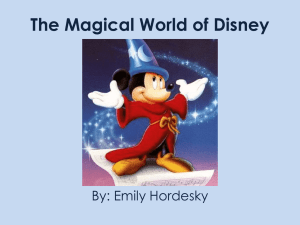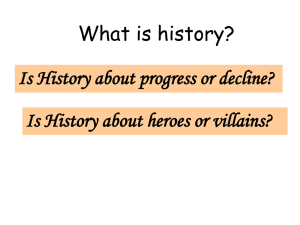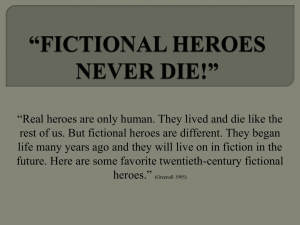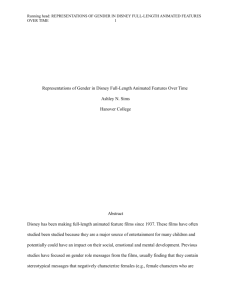PowerPoint
advertisement
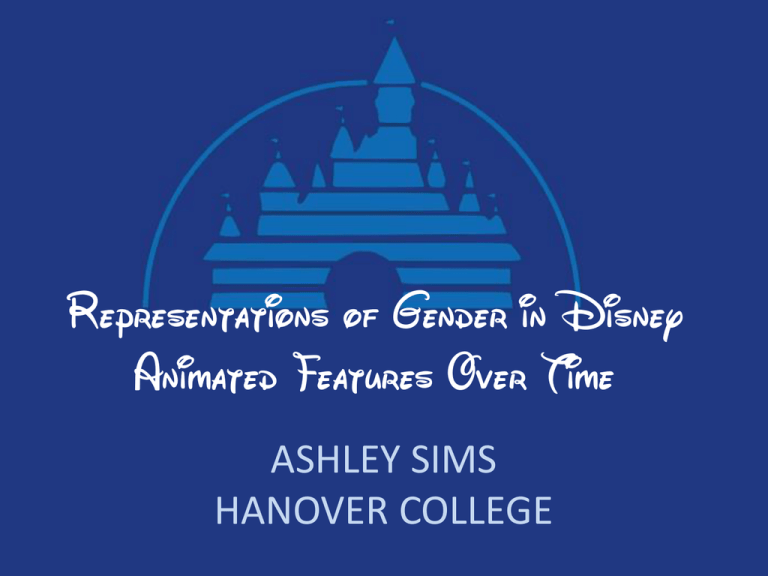
Representations of Gender in Disney Animated Features Over Time ASHLEY SIMS HANOVER COLLEGE Introduction Gender Roles • There are stereotypical behaviors normally associated with either gender, and stereotypical male behaviors tend to be more highly valued than female ones (Broverman 1972). • Stereotypical male behaviors tend to be more highly valued than female ones (McKee & Sherriffs, 1957), but men can also be attributed with negative behaviors. Violence, stubbornness, and a lack of self-control when related to anger or sexual urges are often associated with men, and the stereotypes can be linked to male children acting violently (Watson, 2007). •Children often get messages about stereotypical behaviors through the media they consume (McGhee , 1975; Baker-Sperry, 2007). Introduction Disney and Gender • Disney is the world’s largest media conglomerate by market value (Siklos) and “Hollywood’s biggest single movie producer,” (Maney 1995: 163-164). • In a survey Disney itself conducted, they found that 97% of children aged 2-11 that they surveyed were familiar with Cinderella. Of the 14 characters they asked about, the lowest familiarity rating was given to Eeyore, who still was recognized by 86% of the children surveyed (Bell & Winig, 2009). •With Disney’s characters and stories being so widely known by children, it’s important to analyze the messages expressed in the films. Introduction Past Research on Gender Roles in Disney Movies • With as pervasive as Disney is in our culture, its messages towards children are often brought under scrutiny, and are most often found wanting. • Towbin et al. 2003: “(a) A woman’s appearance is valued more than her intellect; (b)Women are helpless and in need of protection; (c) Women are domestic and likely to marry; (d) Overweight women are ugly, unpleasant, and unmarried.” • Wiersma 1999: found prevalent stereotypical gender behaviors in the films analyzed when coding for physical appearance, personality traits, employment, and power. •Faherty et al. 2001: 63% of the 334 characters represented were male, and only 28% were female, with 9% of the characters being unable to be visually categorized into a gender. Introduction Why over time? • Snow-White and the Seven Dwarfs, the first Disney Animated Feature, came out in 1937, while the latest film, Winnie the Pooh, came out in July 2011. Seventy-four years is a significant amount of time, and this fact seems to be largely ignored by the analyses done beforehand. Observing the changes that the company has made over time will contextualize the gender messages of its current films. Introduction Structure of Storytelling • Freytag’s theory of the Pyramid structure of drama •Expostion-Rising Action-Climax-Falling Action-Conclusion • In the climax the protagonist overcomes or is overcome by the antagonist, and there is often some inner change experienced by the protagonist before he or she moves on to the Denouement, or Conclusion (1894). Research Question • How will the frequency of stereotypical gender behaviors in Disney Animated Features change over time? Method Every other movie in the “Walt Disney Animated Classics” canon (with “package films” like Fantasia removed to keep focus on full-length stories) was watched (mostly) in order of release. Classic vs. Modern: Split down the middle, between “Oliver and Company” and “Beauty and the Beast.” Gender Behavior Coding: Male and female main characters and villains were identified prior to viewing the film and behaviors were coded for the rising action (the action leading up to the climax) and the conclusion of the film. Method Coding • Two heroes and two villains, one of each gender , if possible, identified for coding. •For example, in Sleeping Beauty: Princess Aurora, Prince Phillip, and Maleficent. • Ten Behaviors were rated on a 7-point Likert Scale from stereotypical male behaviors to stereotypical female behaviors. •Strong/Weak, Rough/Gentle, Independent/Dependent, Active/Passive, Unemotional/Emotional, Objective/Subjective, Competitive/Uncompetitive, Logical/Illogical, Dominant/Submissive, and Loud/Quiet. Method Sample Coding Worksheet Hypotheses • Stereotypical gender behaviors of heroes will decrease over time. •Villains’ behaviors will become more stereotypical over time. Results •21 Films •All films have a male hero •18 have a female hero •Villains varied in gender, worked alone •Villains don’t survive climax •New Measure •Computed mean of 8 remaining DVs •Two new variables, Rising Action and Conclusion •Alpha of .8910 •Reliability •ANOVAs •Correlations •Rising Action and Conclusion •Excluded 2 with poor reliability with Time Period, Gender, and Character Type •Independent t-tests •Rising Action, Conclusion and all 20 DVs separately with Time Period, Gender, and Character Type Results •Reliability •Excluded Logical/Illogical and Objective/Subjective •Correlations calculated for all 20 Dependent Variables between the two raters Range of .58-.92 Mean of .80 Results •Some Significant Results from the Independent t-tests •Females are less competitive than males. •Mean of F : 3.92 •Mean of M: 2.818 •p=.030 •Females are quieter than males •Mean of F: 4.12 •Mean of M: 2.606 •p=.009 •Villains are more masculine than heroes . •Mean of Heroes: 3.19 •Mean of Villains: 2.25 •p<.001 Results Interaction between Time Period and Character Type p=.002 Conclusion •Was my hypothesis supported? •Sort of. Females heroes became less stereotypical, but male heroes became more stereotypical. •Females didn’t get masculine any faster than males, which means that their presentation in Disney films is still uneven. •The most striking difference between males and females in general: Loud/Quiet. With a p of .009, females on average were rated two points higher than men. Limitations/Future Directions •I wish I’d had time to watch them all. •Some important films that were not watched: Mulan, Lion King, The Little Mermaid, Princess and the Frog •Conduct my own survey beforehand to see what people think of as the stereotypical traits of men and women to add more validity to that scale •Co-coder was very similar in demographics to me •Future research on this should take it to the kids who are watching it. What do they think about girls and boys after watching Snow White versus Tangled? •The same procedure applied to top-grossing films over the years: is the drift towards masculinity still present? Questions?





